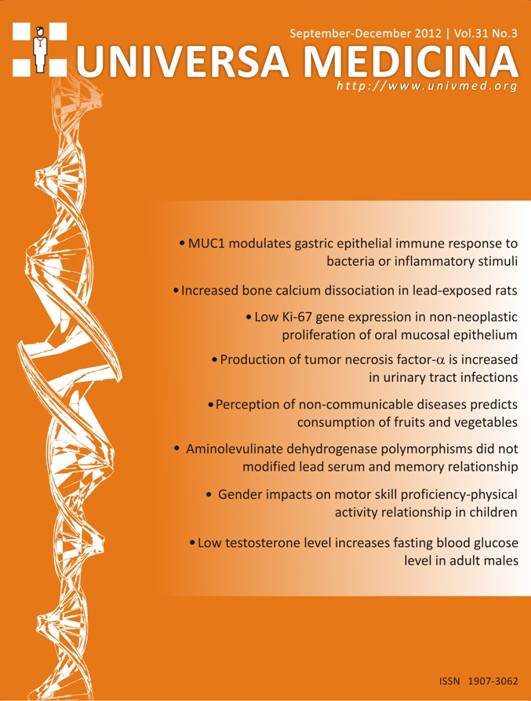Low Ki-67 gene expression in non-neoplastic proliferation of oral mucosal epithelium
Main Article Content
Abstract
Neoplastic and non-neoplastic oral mucosal growths often have a variety of clinical manifestations according to their biological nature. Immunohistochemical diagnostic markers, such as Ki-67, are used to detect their proliferation and differentiation. Ki-67 is expressed in all phases of the cell cycle, except G0. The objective of this study was to determine Ki-67 expression in benign, malignant and non-neoplastic proliferation of oral mucosal epithelium.
METHODS
A laboratory study of cross sectional design was conducted using samples from excised oral mucosa diagnosed as inflammatory gingival hypertrophy (n=5); epulis (n=6); gingival polyps (n=5); pulpal polyps (n=5); papilloma (n=3) and squamous cell carcinoma (n=2). The antigen retrieval endogenous peroxidase
block method was used in the application of Ki-67 primary antibody and chromogen to display the antigen antibody reaction, with positive cells showing brown nucleoplasm staining. The Ki-67 positive index was calculated by dividing the number of positive epithelial cells with the total number of epithelial
cells in the areas observed at 400x magnification. One-way ANOVA was used to compare the Ki-67 indexes of neoplastic and non-neoplastic lesions.
RESULTS
The highest Ki-67 positive index was for squamous cell carcinoma (64.55 ± 23.55%) followed by papilloma (23.33 ± 6.94%), gingival polyps (7.06 ± 7.43%) and gingival hypertrophy (1.40 ± 2.80%). One-way ANOVA showed significant differences in Ki-67 expression between neoplastic and non-neoplastic samples (p<0.05).
CONCLUSIONS
The high Ki-67 expression in neoplasms is proportional to the grade of malignancy. In non-neoplastic processes Ki-67 expression is merely an adaptive response and does not indicate increased Ki-67 proliferative gene expression.
Article Details
Issue
Section
The journal allows the authors to hold the copyright without restrictions and allow the authors to retain publishing rights without restrictions.
How to Cite
References
Soares CP, Zuanon JAS, Teresa DB, Fregonezi PA, Neto1 CB, Oliveira MRB, et al. Quantitative cell-cycle protein expression in oral cancer assessed by computer-assisted system. Histol Histopathol 2006;21:721-8.
Sudiono J, editor. Pemeriksaan patologi untuk diagnosis neoplasma. In: Pemeriksaan patologi untuk diagnosis neoplasma mulut. Jakarta: EGC;2008.p.68-71.
Kovesi G, Szende B. Changes in apoptosis and mitotic index, p53 and Ki-67 expression in various types of oral leukoplakia. Oncology 2003;65:331-6.
Whyte DA, Broton CE. The unexplained survival of cells in oral cancer: what is the role of p53? J Oral Pathol Med 2002;31:25-33.
Rubin E, Strayer D. Cell Injury. In: Rubin E, Gorstein F, Rubin R, Scwarting R, Strayer D, editors. Rubin‘s pathology clinicopathologic foundations of medicine. 4th ed. Baltimore:
Lippincott;2005.p.6.
Klokkevold PR, Mealey BL. Influence of Systemic Disorders and Stress on the Periodontium. In: Newman MG, Takei HH,
Klokkevold PR, Carranza FA Jr, editors. Carranza’s Clinical Periodontology. 10th ed. St.Louis: Saunders;2006.p.284-311.
Eghbalian F, Monsef A. Congenital epulis in the newborn, review of the literature and a case report. J Pediatr Hematol Oncol 2009;31:198-9.
Raju B, Mehrotra R, Jordsbakken G, Al-Sharab AI, Vasstrand EN, Ibrahim SO. Expression of p53, cyclin D1 and Ki-67 in pre-malignant and malignant oral lesions: association with
clinicopathological parameters. Anticancer Res 2005;25:4699-706.
Angieroi A, Berenzi A, Benetti A, Rossi E, Del Sordo R, Sidoni A, et al. Expression of P16, P53 and Ki-67 proteins in the progression of epithelial dysplasia of the oral cavity. Anticancer
Res 2008;28:2535-40.
Szelachowska J, Dziegiel P, Krzeszewska JJ, Jelen M, Matkowski R, Pomiecko A. Mcm-2 protein expression predicts prognosis better than Ki-67 antigen in oral cavity squamocellular
carcinoma. Anticancer Res 2006;26:2473-8.
Dziegiel P, Forgacz J, Suder E, Surowiek P, Kornafel J, Zabel M. Prognostic significance of metallothionein expression in correlation with Ki-67 expression in adenocarcinomas oflarge
intestine. Histol Histopathol 2003;18:401-7.
Dziegiel P, Salwa-Zurawska W, Zurawski J, Wojnar A, Zabel, M. Prognostic significance of augmented metallothionein expression correlated with Ki-67 antigen expression in
selected soft tissue sarcomas. Histol Histopathol 2005;20:83-9.
Souza PEA, Mesquita RA, Gomez RS. Evaluation of p53, PCNA, Ki-67, MDM2 and AgNOR in oral peripheral and central giant cell lesions. Oral Dis 2008;6:35-9.
Iamaroon A, Khemaleelakul U, Pongsiriwe S, Pintong J. Coexpression of p53 and Ki 67 and lack of EBV expression in oral squamous cell carcinoma. J Oral Pathol Med 2004;33:30-6.
Schliephake H. Prognostic relevance of molecular markers of oral cancer - a review. Int J Oral Maxillofac Surg 2003;32:233-45.
Koelbl O, Rosenwald A, Haberl M, Muller J, Reuther J, Flentje M. p53 and Ki-67 as predictive markers for radiosensitivity in
squamous cell carcinoma of the oral cavity? an immunohistochemical and clinicopathologic study. Int J Radiat Oncol Biol Phys 2001;49:147-54.


